German Police NCO/EM's Greatcoat
CATEGORY: Version
SKU: 52.GOR.02.01.03.003.000
Estimated market value:
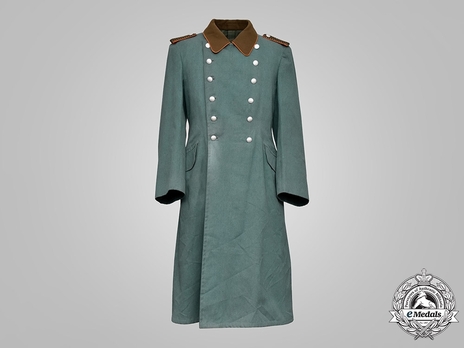
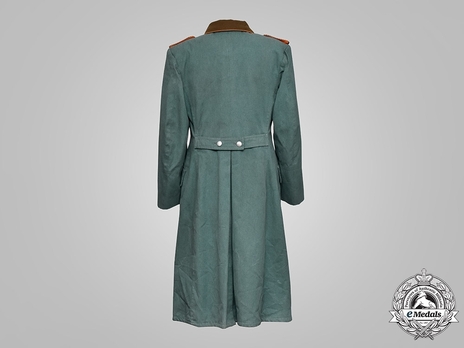
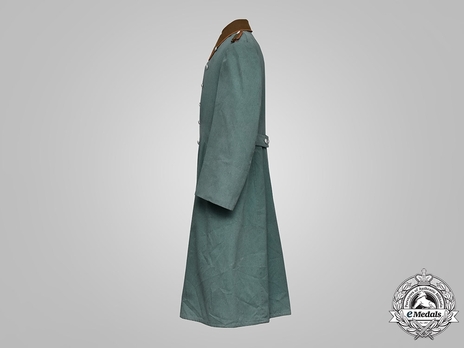
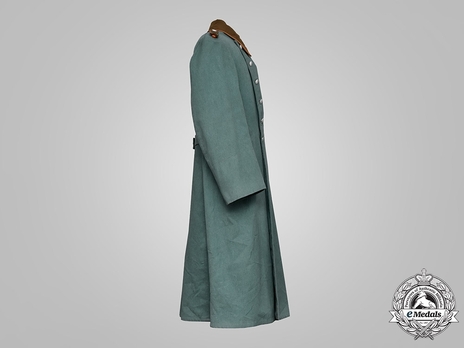
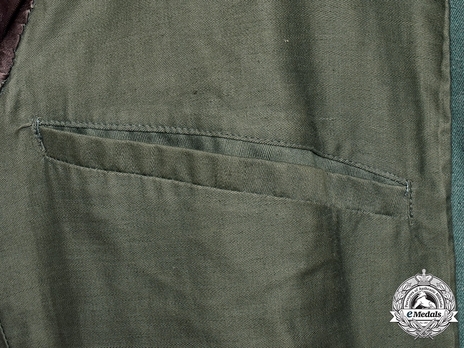
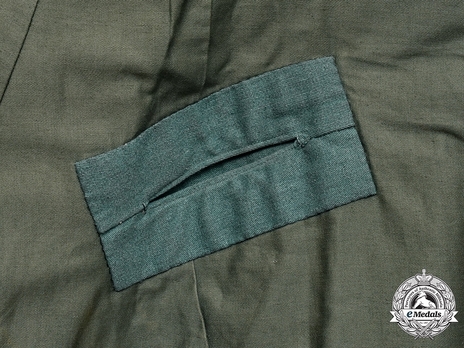
Estimated market value:
A well-preserved, nice quality Police-green wool-rayon blend double-breasted greatcoat, featuring two vertical parallel rows of six silvered, pebbled buttons, maker marked on reverse with the logo for Assmann & Söhne, meeting an equal number of reinforced button holes, with a single metal hook and clasp at the neck with a protective fabric tab, featuring two diagonally angled slash pockets with rounded forward edge flaps at the front of the waist, with a horizontal half waist belt with dual button closure to reverse of waistband, lay down collar constructed of chocolate brown wool bordered by orange wool piping, with sew-on shoulder boards for the rank Unterwachmeister (Junior Watch Master/Constable), each constructed of two 8 mm double-laid wool soutache braids, with the inner and outer braids in dark brown, and the outer braid with evenly space aluminum threads in the form of Vs, over an orange wool base, measuring 35 mm (w) x 115 mm (l), the reverse of the greatcoat presents a central, vertical tail skirt vent measuring 60 cm in length, the interior of the greatcoat is fully lined in with khaki-green cotton-rayon fabric, marked 360 under the lining, presenting minimal wear, measuring 48 cm across the shoulders, 58.5 cm in the sleeves, and 123 cm in total length, and is in overall extremely fine condition.
During the Third Reich, an effort was made to unite all of Germany’s disparate provincial police forces and agencies into a single cohesive national unit. To attain this goal, Reichsführer-SS Heinrich Himmler was named Chief of the German Police in the Ministry of the Interior in June 1936. That same month, Himmler implemented new standardized uniforms, headgear, and insignia. The uniforms worn prior to Himmler’s appointment were often navy blue, particularly in what had been Prussia. The new uniforms were green, in a shade that was then dubbed “Police green”.
The German Police were divided into two main units, the Ordnungspolizei (Orps or Regular Police) and the Sicherheitspolizei (Secret Police); the Ordnungspolizei were unofficially called the green police (Grüne Polizei) as a result of their uniform colour. The Sicherheitspolizei were made up of two main organizations, the Gestapo and the Kriminalpolizei (Criminal Investigation Police). At the beginning of the Second World War, the Sicherheitspolizei were brought under the auspices of the Reich Main Security Office.
The Ordnungspolizei was also divided into smaller branches of service, and each branch was associated with a branch of service/troop colour (Truppenfarbe). The troop colours include:
Schutzpolizei des Reichs (National Protection Police): Green
Schutzpolizei der Gemeinden (Municipal Police) pre-1942: Red
Schutzpolizei der Gemeinden (Municipal Police) post-1942: Green
Gendarmerie (Gendarmes/Rural Police): Orange
Verwaltungspolizei (Administrative Personnel) pre-1942: Red over grey
Verwaltungspolizei (Administrative Personnel) post-1942: Light grey
Feuerschutzpolizei (Fire Protection Police): Carmine
Wasserschutzpolizei (Water Protection Police): Yellow
The uniform garments worn by members of the Wasserschutzpolizei (Water Protection Police) and the Feuerschutzpolizei (Fire Protection Police) remained blue after the 1936 uniform redesign.
The greatcoat was worn by all German police personnel.
These greatcoats are double-breasted, and they feature two vertical rows of six silver-coloured pebbled buttons along the front panel (gold-coloured for General ranks). There are also two silver buttons closing the half-belt on the reverse.
There are two slightly slanted hip-level “slash” pockets with rectangular flaps cut into the greatcoat’s lining.
The collar is covered in additional layers of brown wool, and it is generally bordered in piping whose colour matches the wearer’s branch of service/troop colour (Truppenfarbe).
There are often additional internal pockets cut into the greatcoat’s lining. The lining itself extends throughout the entire greatcoat, with the exception of the area along the backslash, and along the edges of the front panels.

Comments
Sign in to comment and reply.


Scroll Top